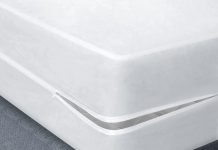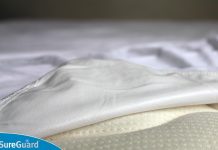Are you tired of wrestling with your mattress protector every night? We feel your pain. There’s nothing worse than constantly readjusting a protector that just won’t stay in place. But fear not, dear reader! In this article, we will share some practical tips and tricks on how to fix an ill-fitting mattress protector. Say goodbye to midnight battles and hello to a peaceful and uninterrupted night’s sleep. You deserve it. Let’s get started, shall we?
Review contents
Common Issues with Ill-fitting Mattress Protectors
Bulging or wrinkling
One of the most common issues with an ill-fitting mattress protector is that it can cause bulging or wrinkling on the surface of the mattress. This not only affects the overall appearance of the bed but also creates discomfort while sleeping. When the protector is too small for the mattress, it can cause excessive tension, leading to uneven distribution of weight and pressure on the mattress surface.
Slipping or shifting
Another problem that arises when using an ill-fitting mattress protector is that it tends to slip or shift during the night. This can be incredibly frustrating as it requires frequent readjustment, interrupting your sleep and causing discomfort. Slipping protectors not only disrupt your sleeping patterns but also fail to provide adequate protection to your mattress, allowing dirt, dust, and spills to reach the mattress surface.
Difficulties in making the bed
Ill-fitting mattress protectors can make the task of making the bed a real challenge. Because they don’t fit properly, they tend to bunch up or create excess folds, which make it difficult to achieve a smooth and tidy appearance. This not only affects the aesthetic appeal of the bedding but also adds unnecessary time and effort to an otherwise simple task.
Exposure of the mattress corners
When a mattress protector is too small or doesn’t fit properly, it often exposes the corners of the mattress. This can lead to increased wear and tear on the mattress fabric, as the exposed corners are more prone to damage from friction or accidental spills. Moreover, the exposed corners also diminish the overall protection provided by the protector, leaving these vulnerable areas susceptible to allergens and moisture.
Noise or discomfort
An ill-fitting mattress protector can create unnecessary noise and discomfort while you sleep. When the protector doesn’t fit snugly, it can cause friction against the mattress material, resulting in annoying and disruptive sounds every time you move. Additionally, the lack of a properly fitted protector may cause discomfort, as it may not provide adequate cushioning or support, impacting your quality of sleep.
Measuring the Mattress Properly
Length and width
To address issues with ill-fitting mattress protectors, it’s important to properly measure the dimensions of your mattress. Start by measuring the length and width of the mattress from edge to edge. Use a measuring tape to ensure accurate measurements and take into account any additional thickness from pillow-top or foam layers. Note down the measurements so that you can refer to them when choosing the right-sized protector.
Thickness or depth
In addition to length and width, it’s crucial to measure the thickness or depth of your mattress. This measurement becomes crucial when selecting a mattress protector as it needs to accommodate the full depth of your mattress. Some protectors come with deep pockets to fit thicker mattresses, so be sure to choose one that matches the depth of your mattress to prevent any issues with bulging or slipping.
Adjusting Elastic Bands and Corners
Changing the elastic bands
For mattress protectors with elastic bands, adjusting or changing them can help alleviate issues with fitting. If the bands are too worn out or loose, they may not provide adequate tension, causing the protector to slip or shift. Replace the elastic bands with new ones that are sturdy and have a good stretch to ensure a snug fit around the mattress. It’s important to choose bands of the correct length that can wrap securely around the corners of the mattress.
Securing corners with clips or straps
In situations where elastic bands alone are not sufficient to secure the corners of the protector, using clips or straps can be an effective solution. Clips or straps can be attached to the corners of the protector and then fastened to the corresponding corners of the mattress. This extra reinforcement helps keep the protector in place and prevents it from bunching up or exposing the corners of the mattress.
Using Mattress Grippers or Toppers
Adding a mattress gripper
To further enhance the fit of your mattress protector, consider adding a mattress gripper underneath it. A mattress gripper is a non-slip pad that is placed between the mattress and the protector. It helps create friction, preventing the protector from slipping or shifting during the night. Additionally, a gripper can provide some extra cushioning and comfort, improving overall sleep quality.
Using a mattress topper
If the ill-fitting mattress protector is causing discomfort due to a lack of cushioning or support, using a mattress topper can help alleviate these issues. A mattress topper is a thicker layer of padding that sits on top of the mattress, providing additional comfort and support. By using a topper of the appropriate thickness, you can compensate for any deficiencies in the protector and enhance the overall feel of your bed.
Purchasing a New Mattress Protector
Considerations for buying a new protector
When faced with an ill-fitting mattress protector, it may be necessary to purchase a new one. Before doing so, it’s important to consider certain factors. Evaluate the specific issues you face with your current protector and look for features in a new protector that address those problems. Consider factors such as breathability, waterproofing, and allergen resistance to ensure that the new protector meets your needs.
Choosing the correct size
To avoid future issues with an ill-fitting protector, it is crucial to choose the correct size for your mattress. Refer to the measurements you took earlier and match them with the sizing options provided by the manufacturer. Be mindful of any variations in mattress thickness and select a protector that can accommodate the specific dimensions of your mattress to ensure a snug and proper fit.
Evaluating the material and features
When purchasing a new mattress protector, pay attention to the material and features offered. Look for protectors made from high-quality fabrics that are durable, hypoallergenic, and comfortable. Consider features such as deep pockets, elasticized corners, and sturdy construction to ensure a secure fit and long-lasting protection for your mattress.
Ensuring Proper Installation
Follow manufacturer’s instructions
To ensure a proper fit and optimal performance, it is crucial to follow the manufacturer’s instructions when installing the mattress protector. Whether it involves stretching the protector or securing corners, the manufacturer’s guidelines will provide specific steps tailored to their product. Following these instructions will help you achieve the best results and avoid potential issues associated with improper installation.
Stretching and smoothing the protector
During installation, make sure to stretch the protector evenly over the mattress to avoid any bulging or wrinkling. Smooth out any creases or folds as you go along to ensure a neat and wrinkle-free surface. Taking the time to properly stretch and smooth the protector will contribute to a better fit and a more comfortable sleeping experience.
Double-checking for any adjustments
Once the protector is installed, double-check for any adjustments or areas that may need additional attention. Look out for corners that may have slipped off or areas that are bunching up. Smooth out these sections and make any necessary adjustments to ensure that the protector is securely in place and properly covering the entire mattress.
Seeking Professional Assistance
Consulting with a mattress specialist
If you are still facing issues with an ill-fitting mattress protector, consider consulting with a mattress specialist. These experts can provide valuable insight and guidance on selecting the right protector for your specific needs. They can also offer recommendations on adjustments or alternative solutions to address the issues you are facing, ensuring that you achieve a comfortable and well-protected mattress.
Hiring a professional mattress fitter
In more complex cases, it may be worth hiring a professional mattress fitter. These experts specialize in finding the perfect fit for mattress protectors and can provide tailored solutions to your specific mattress issues. A professional fitter will take precise measurements, recommend the most suitable protector, and ensure a flawless installation, leaving you with a well-fitted protector that perfectly complements your mattress.
DIY Fixes for Temporary Solutions
Using safety pins
If you need a quick and temporary fix for an ill-fitting mattress protector, safety pins can come to the rescue. Carefully attach safety pins along the edges of the protector, securing it to the mattress. Be cautious not to puncture the mattress or tear the fabric of the protector. While this is not a permanent solution, it can help keep the protector in place until a more suitable long-term option is identified.
Employing Velcro strips
Another DIY fix involves using Velcro strips to secure the corners of the protector. Attach one side of the Velcro strip to the corner of the protector and the matching side to the corresponding corner of the mattress. This will create a firm and adjustable connection, preventing the protector from slipping or shifting. Velcro strips offer a convenient and non-damaging solution for achieving a snug fit.
Utilizing rubber bands
For a simple and cost-effective temporary solution to address slipping protectors, rubber bands can be employed. Wrap the rubber bands around the corners of the protector, pulling them taut and fastening them securely to the base of the mattress. This will help hold the protector in place and minimize any movement during sleep. Rubber bands are readily available and can provide a quick fix until a more permanent solution is implemented.
Preventing Future Problems
Proper maintenance and cleaning
To avoid issues with an ill-fitting mattress protector in the future, it’s essential to follow proper maintenance and cleaning practices. Regularly remove and launder the protector according to the manufacturer’s instructions to keep it fresh, clean, and in good condition. This will prevent any shrinkage or deformation that could affect the fit of the protector.
Regularly checking for wear and tear
Periodically inspect your mattress protector for signs of wear and tear. Check for loose or stretched elastic, frayed edges, or any other damage that may compromise the fit or functionality of the protector. Address any issues promptly to prevent further deterioration and ensure the continued effectiveness of the protector.
Replacing the protector when necessary
Even with proper care, there will come a time when a mattress protector needs to be replaced. Over time, the materials may lose their effectiveness, shrink, or become too worn out to offer adequate protection or a proper fit. Evaluate the condition of your protector periodically and if you notice significant wear or damage, it’s time to invest in a new one to maintain the integrity of your mattress.
Conclusion
Having an ill-fitting mattress protector can be a frustrating experience, but with the right knowledge and solutions, it’s a problem that can be easily resolved. By measuring your mattress properly, making adjustments to the protector, and considering the use of additional accessories, you can improve the fit and functionality of the protector. If necessary, seek professional assistance or utilize temporary DIY fixes until a suitable long-term solution is found. By taking proper care and replacing the protector when needed, you can ensure a comfortable and well-protected mattress for years to come.
































